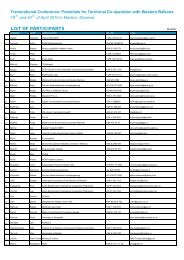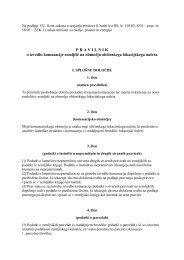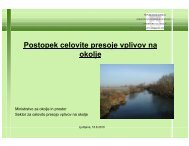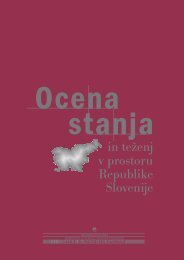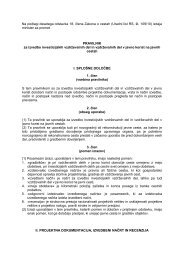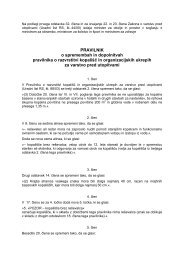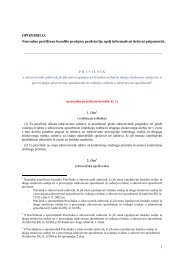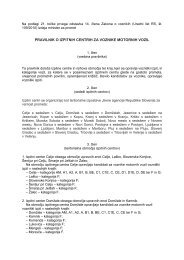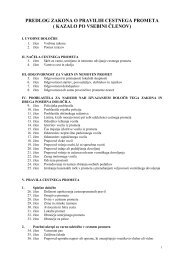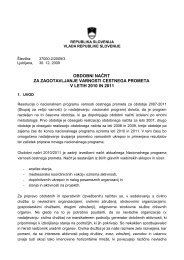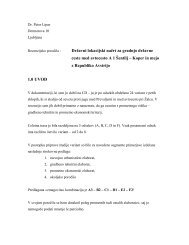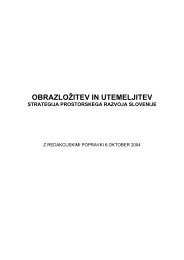evropska konvencija o krajini - Ministrstvo za infrastrukturo in prostor
evropska konvencija o krajini - Ministrstvo za infrastrukturo in prostor
evropska konvencija o krajini - Ministrstvo za infrastrukturo in prostor
Create successful ePaper yourself
Turn your PDF publications into a flip-book with our unique Google optimized e-Paper software.
Kraj<strong>in</strong>a kot vir <strong>za</strong> razvoj turizma (Istra)»Istrska ogrlica otokov«Landscape as a tourism development resource (Istria)»Istrian necklace of islands«Eduard Kušen142Delavnica 2 / Workshop 2O razvrščanju turističnih (razvojnih) virovČe govorimo o varovanju okolja, varovanjunaravne dedišč<strong>in</strong>e, varovanju kulturnededišč<strong>in</strong>e, fizičnem načrtovanju, vrtnarstvu,načrtovanju mest <strong>in</strong> turizmu, praviloma vednozmanjka časa ali <strong>prostor</strong>a <strong>za</strong> sistematičnoopredelitev <strong>in</strong> sprejem razvrstitve vsehturističnih virov. Splošna praksa v turizmu je, dasamo <strong>za</strong>konsko varovana <strong>in</strong> v kataloge vpisanakulturna <strong>in</strong> naravna bogastva štejejo <strong>za</strong>turistične znamenitosti. Zdi se, da zunaj tehkatalogov ne obstaja nobena druga potencialnaali dejanska turistična znamenitost (vir), kot jeprivlačna kraj<strong>in</strong>a, kar pa seveda ni res.Avtor te razprave je temu vprašanju posvetilknjigo z naslovom »Osnova <strong>za</strong> turističnoprivlačnost« 1 , v kateri najprej razvrsti vseturistične vire kot potencialne ali dejansketuristično privlačne točke ter neposredne aliposredne turistične vire. Turistično privlačnetočke razvrsti v 16 kategorij, glede na to, al<strong>in</strong>aravna kraj<strong>in</strong>a kot turistični razvojni vir spada vkategorijo rastl<strong>in</strong> <strong>in</strong> varovane naravne dedišč<strong>in</strong>e,medtem ko kultivirana kraj<strong>in</strong>a spada v kategorijorastl<strong>in</strong>, varovane naravne dedišč<strong>in</strong>e, varovanekulturne <strong>in</strong> zgodov<strong>in</strong>ske dedišč<strong>in</strong>e ter kultureživljenja <strong>in</strong> dela.Naravne <strong>in</strong> kultivirane kraj<strong>in</strong>e so objektivnostalen <strong>in</strong> neobhoden element turističnih virov,posebej pri razvoju podeželskega <strong>in</strong> športnega/rekreacijskega turizma ter ekološkega turizma,vendar gre tudi <strong>za</strong> elemente drugih vrst turizma,na primer pomorskega.Dolgoročna razvojna strategija turizma v Hrvaškidaje zelo majhen pomen naravnim <strong>in</strong>About the classification of tourism (development)resourcesWith<strong>in</strong> the l<strong>in</strong>es of <strong>in</strong>terest of environmental protection,natural heritage protection, cultural heritageprotection, physical plann<strong>in</strong>g, horticulture,town plann<strong>in</strong>g, and tourism, as a rule, there alwaysrema<strong>in</strong>s little time or space to systematicallyidentify and accept classification of all tourismresources. The common practice <strong>in</strong> tourismis that only cultural and natural assets be<strong>in</strong>g legallyprotected and catalogued are consideredtourism attractions. It would seem that outsidethese catalogues, there exist no other potentialor real tourism attractions (resources), such asan appeal<strong>in</strong>g landscape, which is just not true.The author of this paper has dedicated a bookto this issue, entitled »Tourism attraction base« 1 ,<strong>in</strong> which he first classifies all tourism resourcesas potential or real tourism attractions, as wellas direct or <strong>in</strong>direct tourism resources. He classifiesthe tourism attractions <strong>in</strong>to 16 categories,accord<strong>in</strong>g to which a natural landscape as atourism development resource may fall <strong>in</strong> thecategory of plants and protected natural heritage,while a cultivated landscape would be <strong>in</strong> thecategory of plants, protected natural heritage,protected cultural and historical heritage, andliv<strong>in</strong>g and work<strong>in</strong>g culture.Natural and cultivated landscapes are, objectively,a fixed and unavoidable element of tourismresources, especially concern<strong>in</strong>g the developmentof rural and sports/recreational tourism,as well as eco-tourism, but are also elements ofother types of tourism, e. g. nautical.



